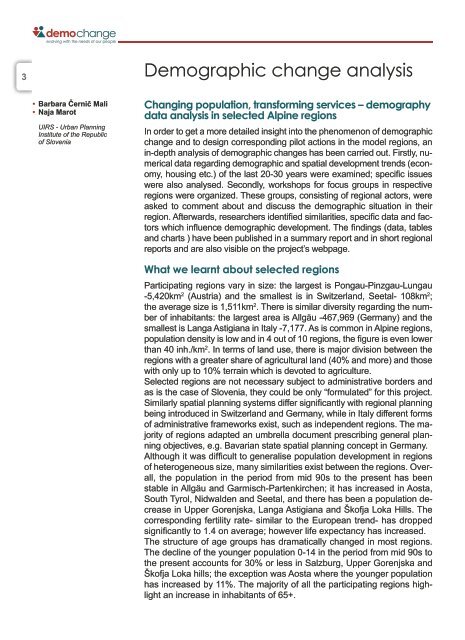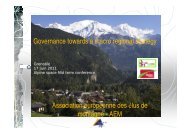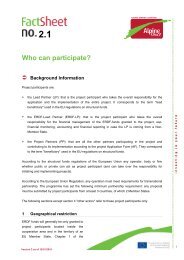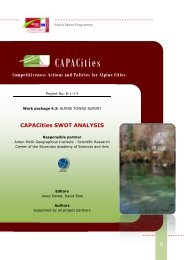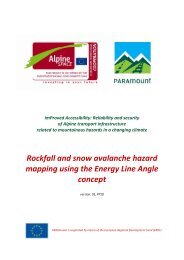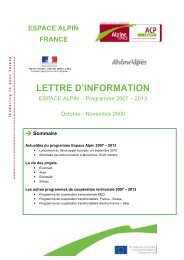aDaptation strategies to spatial planning anD regional Development
aDaptation strategies to spatial planning anD regional Development
aDaptation strategies to spatial planning anD regional Development
You also want an ePaper? Increase the reach of your titles
YUMPU automatically turns print PDFs into web optimized ePapers that Google loves.
3 Demographic change analysis<br />
• Barbara Černič Mali<br />
• Naja Marot<br />
UIRS - Urban Planning<br />
Institute of the Republic<br />
of Slovenia<br />
Changing population, transforming services – demography<br />
data analysis in selected Alpine regions<br />
In order <strong>to</strong> get a more detailed insight in<strong>to</strong> the phenomenon of demographic<br />
change and <strong>to</strong> design corresponding pilot actions in the model regions, an<br />
in-depth analysis of demographic changes has been carried out. Firstly, numerical<br />
data regarding demographic and <strong>spatial</strong> development trends (economy,<br />
housing etc.) of the last 20-30 years were examined; specific issues<br />
were also analysed. Secondly, workshops for focus groups in respective<br />
regions were organized. These groups, consisting of <strong>regional</strong> ac<strong>to</strong>rs, were<br />
asked <strong>to</strong> comment about and discuss the demographic situation in their<br />
region. Afterwards, researchers identified similarities, specific data and fac<strong>to</strong>rs<br />
which influence demographic development. The findings (data, tables<br />
and charts ) have been published in a summary report and in short <strong>regional</strong><br />
reports and are also visible on the project’s webpage.<br />
What we learnt about selected regions<br />
Participating regions vary in size: the largest is Pongau-Pinzgau-Lungau<br />
-5,420km 2 (Austria) and the smallest is in Switzerland, Seetal- 108km 2 ;<br />
the average size is 1,511km 2 . There is similar diversity regarding the number<br />
of inhabitants: the largest area is Allgäu -467,969 (Germany) and the<br />
smallest is Langa Astigiana in Italy -7,177. As is common in Alpine regions,<br />
population density is low and in 4 out of 10 regions, the figure is even lower<br />
than 40 inh./km 2 . In terms of land use, there is major division between the<br />
regions with a greater share of agricultural land (40% and more) and those<br />
with only up <strong>to</strong> 10% terrain which is devoted <strong>to</strong> agriculture.<br />
Selected regions are not necessary subject <strong>to</strong> administrative borders and<br />
as is the case of Slovenia, they could be only “formulated” for this project.<br />
Similarly <strong>spatial</strong> <strong>planning</strong> systems differ significantly with <strong>regional</strong> <strong>planning</strong><br />
being introduced in Switzerland and Germany, while in Italy different forms<br />
of administrative frameworks exist, such as independent regions. The majority<br />
of regions adapted an umbrella document prescribing general <strong>planning</strong><br />
objectives, e.g. Bavarian state <strong>spatial</strong> <strong>planning</strong> concept in Germany.<br />
Although it was difficult <strong>to</strong> generalise population development in regions<br />
of heterogeneous size, many similarities exist between the regions. Overall,<br />
the population in the period from mid 90s <strong>to</strong> the present has been<br />
stable in Allgäu and Garmisch-Partenkirchen; it has increased in Aosta,<br />
South Tyrol, Nidwalden and Seetal, and there has been a population decrease<br />
in Upper Gorenjska, Langa Astigiana and Škofja Loka Hills. The<br />
corresponding fertility rate- similar <strong>to</strong> the European trend- has dropped<br />
significantly <strong>to</strong> 1.4 on average; however life expectancy has increased.<br />
The structure of age groups has dramatically changed in most regions.<br />
The decline of the younger population 0-14 in the period from mid 90s <strong>to</strong><br />
the present accounts for 30% or less in Salzburg, Upper Gorenjska and<br />
Škofja Loka hills; the exception was Aosta where the younger population<br />
has increased by 11%. The majority of all the participating regions highlight<br />
an increase in inhabitants of 65+.


